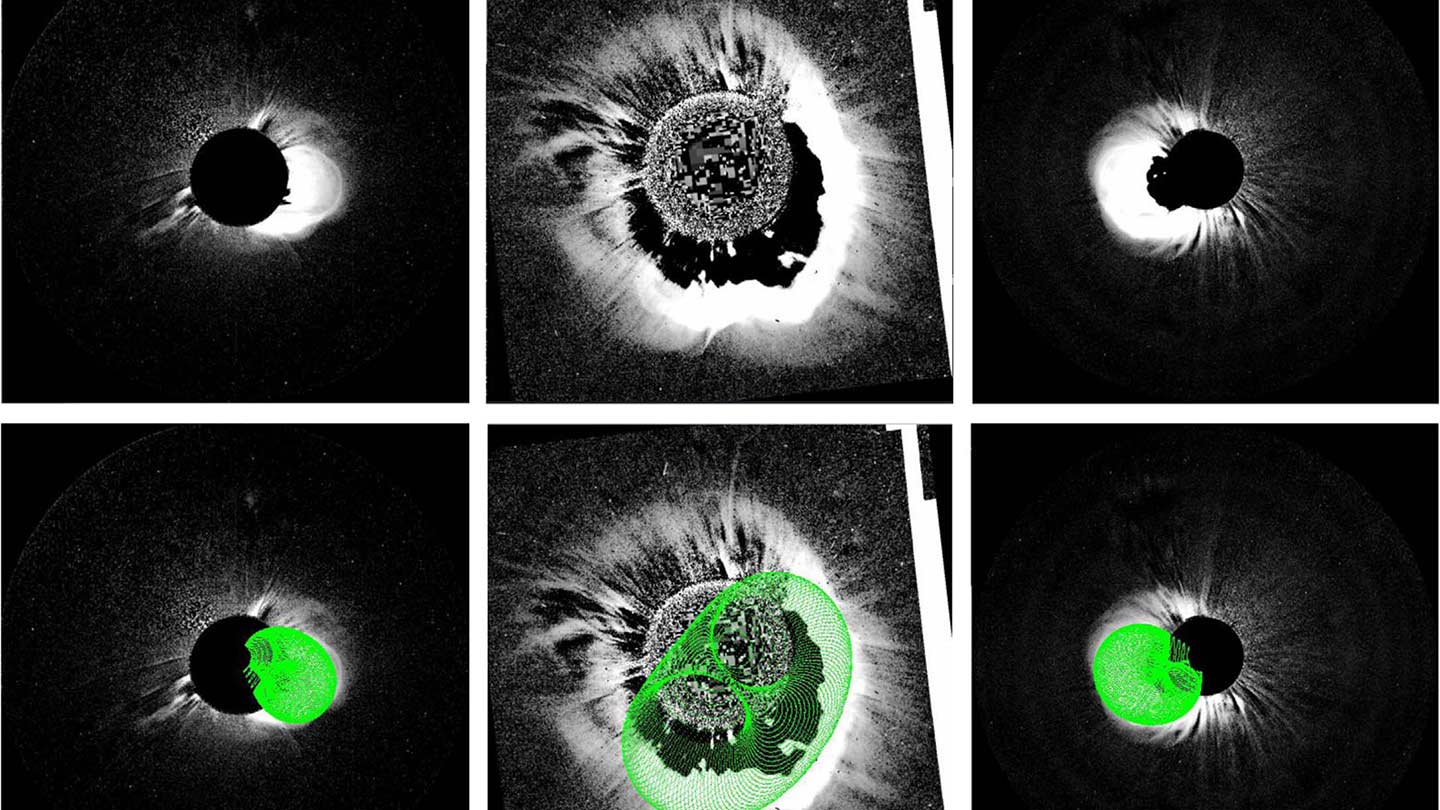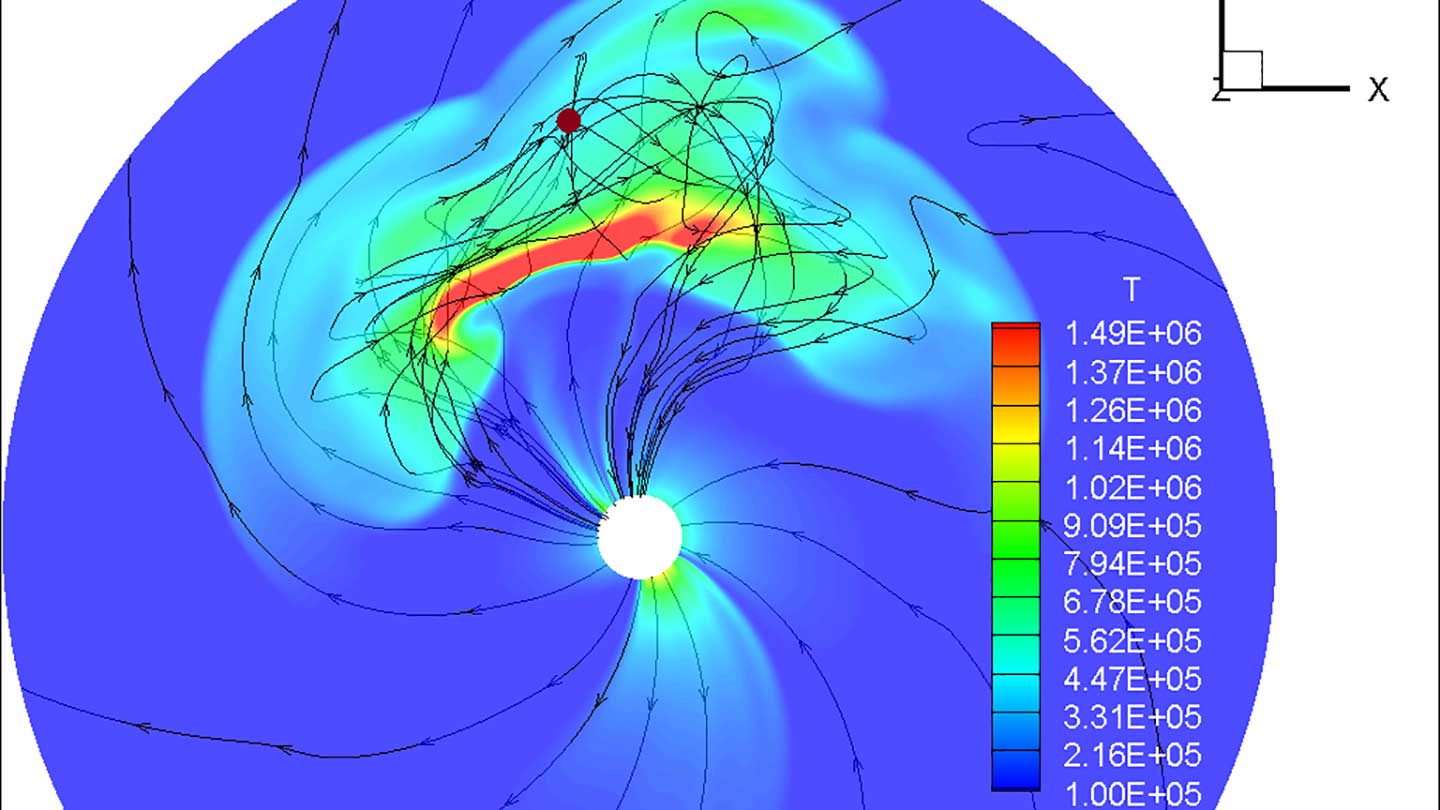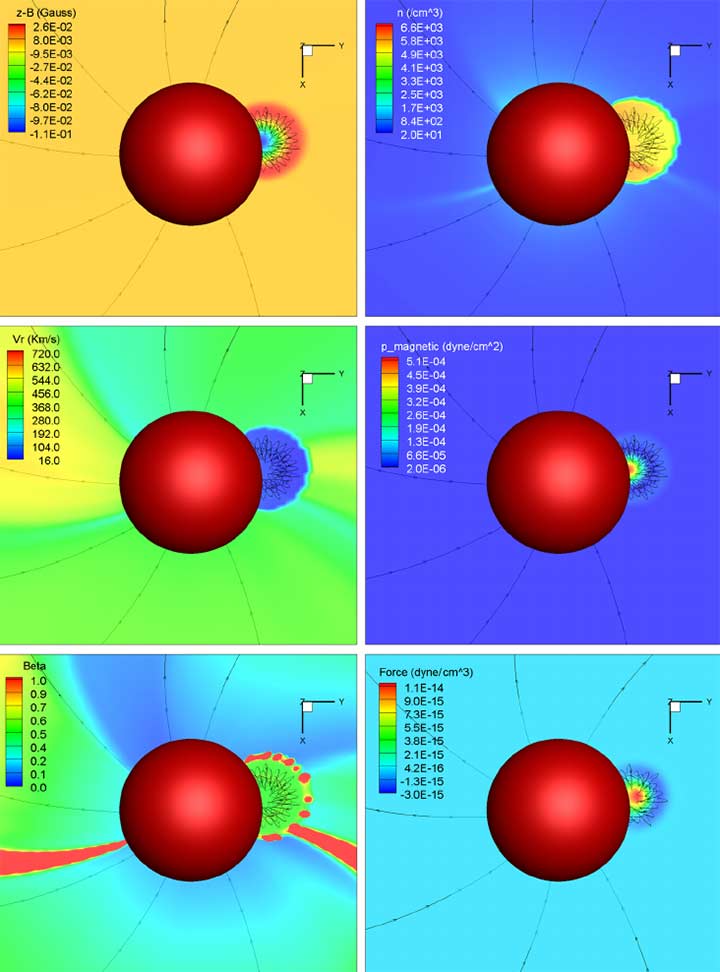
Top panel, from left: A July 12, 2012, coronal mass ejection seen in STEREO B Cor2, SOHO C2, and STEREO A Cor2 coronagraphs, respectively. Bottom panel: The same images overlapped with the model results.
Talwinder Singh, Mehmet S. Yalim, Nikolai V. Pogorelov and Nat Gopalswamy / American Astronomical Society
Research to improve space weather predictions by Dr. Nikolai Pogorelov at The University of Alabama in Huntsville (UAH), a part of the University of Alabama System, will boost abilities crucial to the success of the defense mission of the U.S. Space Command that’s set to be located here.
“The cutting-edge research being done by Dr Pogorelov, and indeed many of the Center for Space Plasma and Aeronomic Research (CSPAR) and Department of Space Science (SPA) researchers, is of immediate interest to the U.S. Space Command because it provides the kind of forecasting and predictive capabilities that are essential to the protection of our military and civilian space-based assets,” says Dr. Gary Zank, CSPAR director and SPA chair.
The Space Force will be concerned with the integrity and resilience of communications, global positioning and navigation, and short- and long-term response to natural threats initiated by solar disturbances, Dr. Zank says, whether they are from disruptions to the Earth's magnetosphere or the rapid intensification of highly energetic particles capable of destroying satellite components.
“For this, an understanding and predictive capability for the complex solar-geospace coupling is critical,” he says.
The work of Dr. Pogorelov and his colleagues, which has been acknowledged by the NSF, illustrates that Huntsville possesses the scientific and technical expertise to support the new headquarters, Dr. Zank says.
“Indeed, UAH through its CSPAR/SPA researchers are leading world-class research programs that are important to space weather and so would be critical to the Space Force's mission,” he says.
Dr. Pogorelov, a distinguished professor in UAH’s SPA and at CSPAR, is the principal investigator for the UAH-led, three-year, $3.2 million National Science Foundation (NSF) and NASA project to develop the physical and computational aspects of solar atmosphere and inner heliosphere software models useful to predict space weather.

The coronal mass ejection threaded by magnetic field lines in the equatorial slice, colored by plasma temperature.
From Space Weather April 2020 / American Geophysical Union
Solar storms can be strong enough to send highly-magnetized plasma battering through the Earth’s magnetosphere, the magnetic shield that protects the planet. The disruptions could hamper a space defense system, damaging electrical grids, satellites, sensitive electronics and the equipment needed to communicate with the kinds of spacecraft on which the Space Force will rely.
Those potentially catastrophic effects make accurate space weather prediction a vital goal for national defense.
“The solar wind emerging from the sun is the main driving mechanism of solar events, which may lead to geomagnetic storms that are the primary causes of space weather disturbances that affect the magnetic environment of Earth and may have hazardous effects on space-borne and ground-based technological systems, as well as human health,” Dr. Pogorelov says. “For this reason, accurate modeling of the solar wind is a necessary part of space weather forecasting.”
Dr. Pogorelov’s research team uses the Frontera supercomputer at the Texas Advanced Computing Center (TACC) at The University of Texas at Austin, the ninth fastest in the world, and computers at the NASA Advanced Supercomputing Facility at NASA's Ames Research Center and the San Diego Supercomputer Center.
The project team includes UAH, Lawrence Berkeley National Laboratory (co-principal investigator Brian Van Straalen), Goddard Space Flight Center (GSFC; co-principal investigator Charles N. Arge), Marshall Space Flight Center (MSFC; co-principal investigator Ghee Fry), and two private companies, Predictive Science Inc. (co-principal investigator Jon Linker) and Space Systems Research Corp. (co-principal investigator Lisa Upton).

Magnetic field line configuration of the coronal mass ejection inserted at the inner boundary R = 0.1 AU, shown with the red sphere.
Talwinder Singh, Tae K. Kim , Nikolai V. Pogorelov and Charles N. Arge / American Geophysical Union
The team is focused on improving the software, modeling and methodology necessary to accurately predict solar weather events, but other new science is emerging from the research. The diversity of the team makes it possible to address challenges in coupling the models of the solar corona and inner heliosphere.
Recently, Dr. Pogorelov – along with Dr. Michael Gedalin of Ben Gurion University of the Negev, Israel, and Dr. Vadim Roytershteyn of the Space Science Institute – described in Astrophysical Journal the shock acceleration of non-thermal ions in the universe. Such ions are either of interstellar or local origin. They are picked up by the magnetized solar wind plasma and move radially outwards from the sun.
“Some non-thermal particles can be further accelerated to create solar energetic particles that are particularly important for space weather conditions on Earth and for people in space,” Dr. Pogorelov says.
Using the fastest national computers, Dr. Pogorelov with his team at SPA and CSPAR performed simulations to better understand physical processes occurring in the solar wind and compare them with observations from New Horizons, Parker Solar Probe, Ulysses and Voyager 1 and 2, the spacecraft that explored the outer reaches of the heliosphere and are now providing data from the local interstellar medium.
Correctly forecasting the arrival at Earth of coronal mass ejections and determining the direction of the magnetic field is essential to space weather prediction, and a study of non-thermal ions by Dr. Pogorelov's team helped that effort, as did work published in the Astrophysical Journal in 2020 that used a flux rope-based magnetohydrodynamic model to predict the arrival time to Earth and magnetic field configuration of the July 12, 2012, coronal mass ejection.
“The connection of the interplanetary magnetic field to CME-related shocks and impulsive solar flares determines where solar energetic particles propagate,” Dr. Pogorelov says. “Data-driven modeling of stream interactions in the background solar wind and CMEs propagating through it are necessary parts of space weather forecasting.”

Dr. Nikolai Pogorelov is the principal investigator of a $3.2 million, UAH-led National Science Foundation and NASA project effort to better predict space weather.
Michael Mercier / UAH
Currently, the National Oceanic and Atmospheric Administration Space Weather Prediction Center forecasts the state of the ambient solar wind and the arrival time of CMEs using an empirically-driven solar wind model. Dr. Pogorelov’s team is charged by the NSF and NASA with developing a new generation software for space weather predictions. It will use adaptive mesh refinement to increase predictive capabilities, take advantage of modern computer architectures and is projected to serve the heliospheric community for many years.
“Fifteen years ago, we didn't know that much about the interstellar medium or solar wind properties. We have so many observations available today, which allow us to validate our codes and make them much more reliable,” Dr. Pogorelov says.
“The new models will provide more accurate solutions and will all be scalable on massively parallel systems, including Graphics Processor Units,” he says. “In addition to improving space weather predictions at Earth, our developed models and software will be data driven. They will be based on the observational data and shed light onto physical processes occurring on the sun and in interplanetary space.”